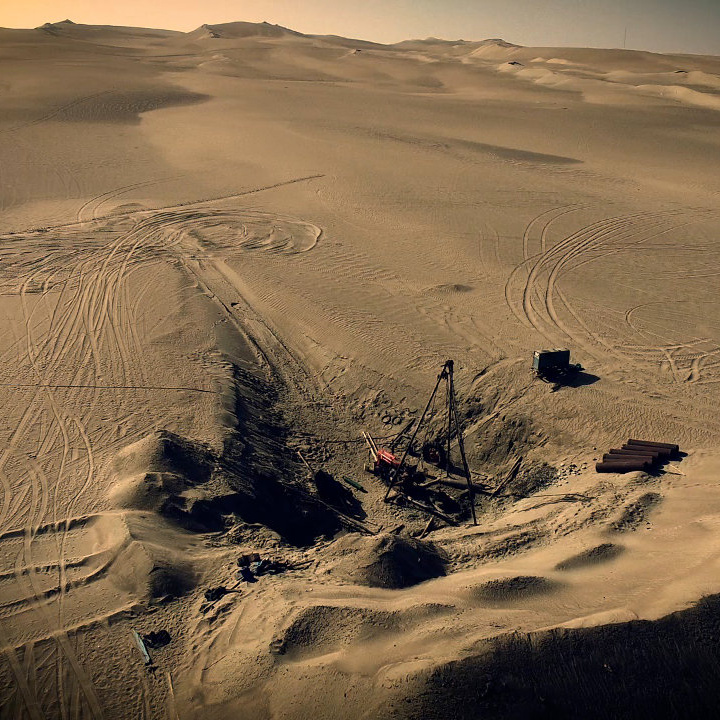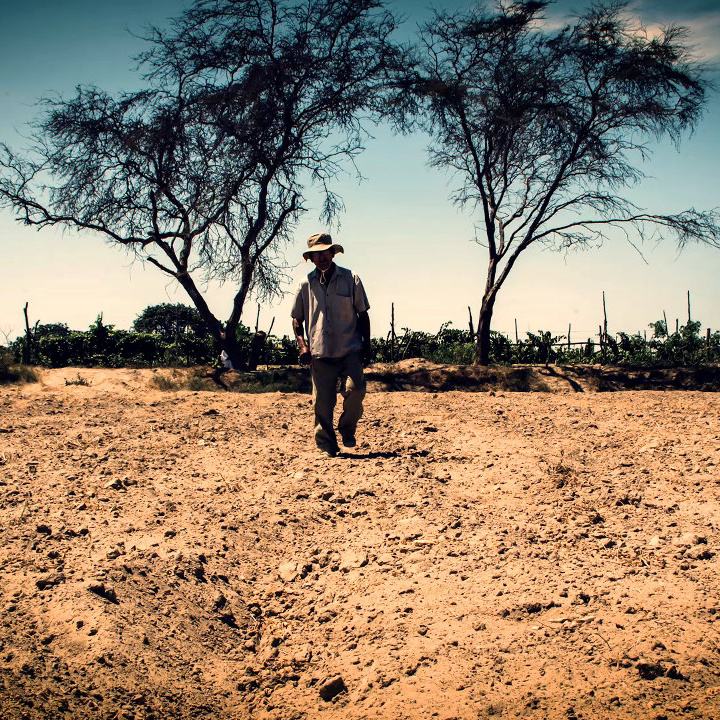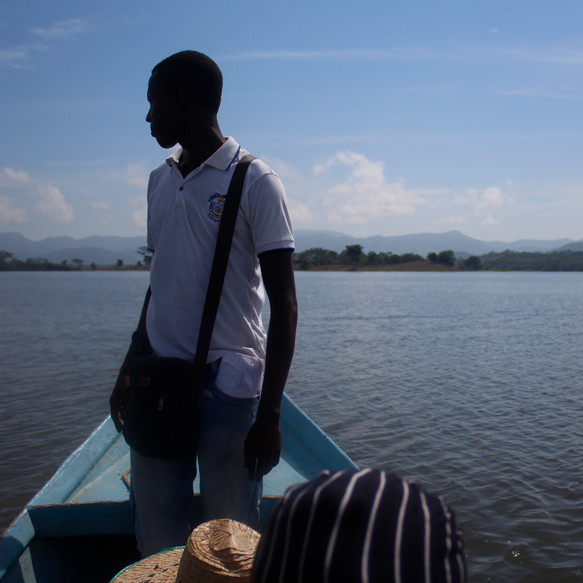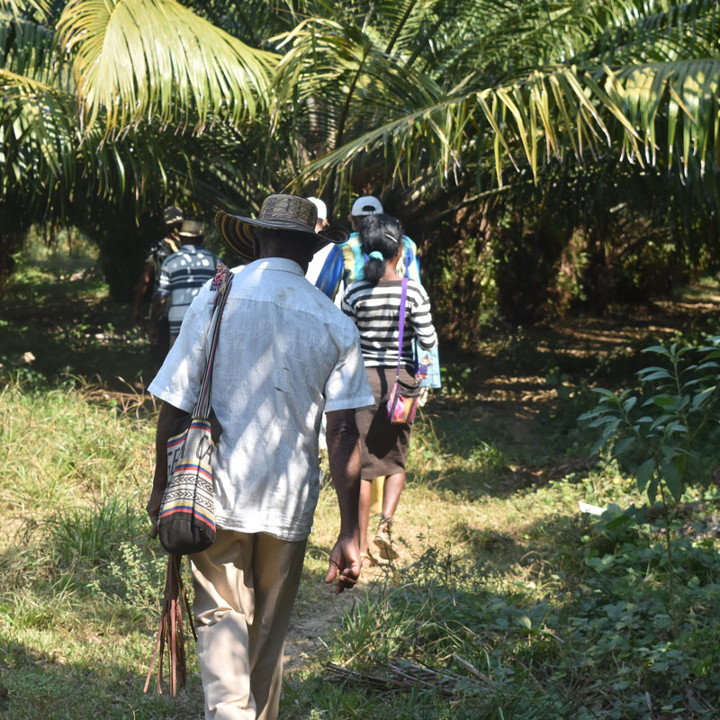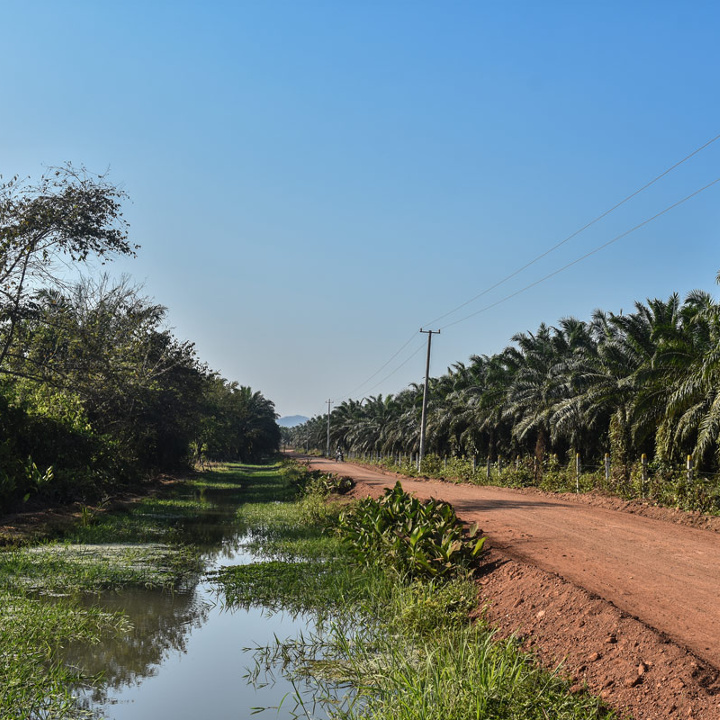One morning in April a white drone rose slowly over the Villacurí in the desert of Ica. The two people guiding it from the ground kept simultaneous lookout for the presence of private security guards keen to shoot the small machine down. Villacurí looked like a ghost town, other than for a few pickup trucks along the highway looking to enter the properties of agro-export companies enclosed by walls of cement and timber. From a height of 100 meters in the air, one of the world’s main asparagus-producing areas seemed like a field dotted with strips of green mesh. Each one was camouflage for a well extracting water from the subsoil to irrigate the extensive plantations.
The panorama shown in these aerial images by Ojo-publico.com confirmed a serious problem that can be translated into figures: according to a National Water Authority (ANA) registry prepared by inspectors a year ago, at least 314 of the 474 wells identified in the area operate without a license. It is for this reason that Ica has been in a state of water emergency since 2005 and Villacurí faces a devastating forecast: the land will be unable to support agriculture this year because the groundwater no longer replenishes naturally.



At the beginning of this century Villacurí was a showcase example of private companies making possible the so-called Peruvian agro-export miracle. But this would be short-lived. Today, there are 139 agro-exporters in need of 83 million cubic meters of water per year to irrigate their crops—the equivalent of 33,190 Olympic swimming pools. Indeed, these consumption calculations represent an underestimate, since they are based only on official reports and do not include volumes extracted from the informal wells. “Most companies do not allow us to monitor them,” says Renato Ceccarelli, an inspector from the Río Seco Local Water Authority, which is charged with controlling the use of the resource in Lanchas and Villacurí.
A ban on the boring of new wells in the Ica region has existed for 13 years. It has remained unenforced, however, because ANA itself, which is an agency within the portfolio of the Ministry of Agriculture, has approved extraordinary regulations and granted special concessions which have enabled the agro-export companies leading the boom to overexploit the groundwater reserves. We discovered this after reviewing for this investigation a score of resolutions issued between 2008 and 2017 during the terms of seven agriculture ministers, two of whom, Ismael Benavides (2007 - 2008) and Rafael Quevedo (2010 - 2011), were themselves owners of agro-export companies.
Inspectors intimidated
Earlier this year inspector Renato Ceccarelli identified three informal wells on land belonging to Agrícola San Pedro, a company dedicated to the growing of table grapes located 270 kilometers from Lima on the Pan-American Highway South. When he arrived at the entrance gate two armed security guards informed him that the owners were absent and he could not enter the premises. Despite this challenge, the Río Seco Local Water Authority supervisor used a drone to register the drilling and drafted an official report, which he subsequently forwarded on to ANA. It is not known whether a process to fine the company has commenced.

Last April, the Río Seco Local Water Authority organized and trained eleven people to inspect wells in Villacurí and Lanchas over a five-month period. However, from the very first day of the scheduled activities the efforts were frustrated when not a single company allowed the inspectors to enter its property. That same month, the Ojo-publico.com drone flight recorded three wells in the vineyards of Greenvic, an agro-export company belonging the Guilisasti family of Villacurí.
The company had formalized the use of a groundwater well in 2014. But we could found no permits for the two additional bores we observed and that had been covered with the green mesh. The company failed to answer our telephone calls or respond to the questions we sent by mail.
The agro-exporters are blocking any activity aimed at monitoring in Ica. Three companies have already filed complaints about the flying of drones over their properties and have threatened to report inspectors for abuse of authority. “Water has become a private good in this region,” says researcher Gerardo Damonte, author of an academic study on the power of the companies that control Ica’s groundwater. 1 .
Damonte and two of his research collaborators interviewed several supervisors from the local water authorities of Ica and Río Seco between August and September 2015. The testimonies revealed how the state has ceded control of subsoil water to large agricultural companies. As one of the Río Seco inspectors said, “They close the doors on us and we are left with nothing to do except bang on them.” According to one of this colleagues who gave a statement on the condition of anonymity: “We ended up being reported just for inspecting.”
Power and impunity
The former minister of agriculture, Ismael Benavides Ferreyros, an owner of agro-exporting grape and asparagus businesses in Ica, was involved in an episode that illustrates the pressure that ANA inspectors find themselves under. In November 2012, the then head of the Río Seco Local Water Authority Agustín González Bravo took a prosecutor to the former minister's farm following a report that an informal well was in operation there. The complaint had been filed by another company, Agroinversiones Valle y Pampa, owned by the Bentín family. However, González was unable to enter or undertake an inspection due to the absence of the owners and the presence of security guards, who went as far firing shots into the air to force him and the prosecutor to withdraw.
This event is recorded in a report that was sent to ANA. The document shows that, as stipulated by law, Benavides had been notified of the planned inspection three days in advance. Yet the former minister's response was to slap the official with an administrative complaint alleging that it had been improper of González to act on a report provided by a rival company. Although this complaint was thrown out at the end of 2012, by May 2013 Benavides had proceeded to sue the inspector for abuse of authority before the Office of the Prosecutor. At that time González had finished his contract with ANA and was therefore without support from the state to contest the legal process.

What happened with Gonzalez was neither an isolated episode nor without precedent. In May 2011 the Comptroller General had opened an investigation against ten employees of the Río Seco Local Water Authority following a complaint from another Villacurí agro-exporter. It had recommended their prosecution for civil disturbance, criminal association, breach of function, and abuse of authority. Various supervisors were named: Javier Chiong Ampudia, Óscar Arrasco Yarrín, Ángel García Canela, Raúl Becerra Moreno, Jorge Cornejo Merino, Hildebrando Ayasta Cornejo, Manuel Ayasta Cornejo, Oscar Ávalos Sanguinettí, Glicerio Yataco Hernández, and Diómedes Junes Cornejo.
Nearly seven years later, in March, an Ica judge dismissed the case, ruling that there was insufficient evidence to convict. “Complaining about abuse of authority by supervisors has become a strategy that companies use to resist inspection,” says researcher Gerardo Damonte. The job of inspector offers little stability and turnover levels are high. Most do not last more than eight months. “Those who do their work feel uncomfortable. The ones who last the longest are those who decide to not take on the businessmen,” says Renato Ceccarelli, from the Río Seco Local Water Authority.
ANA denies that there is a problem and gave only a brief response, by mail, to Ojo-publico.com: “There were no complaints filed against our supervisors for abuse of authority in the period 2011-2018.” However, the documents we obtained belie this version and show that at least 12 officials and former officials in Ica have been reported by agro-export companies for alleged abuse of authority during the period in question.
The perpetual amnesty
Some 20 heads of local water authorities in the south of the country met in Lima at the beginning of 2011 to discuss a measure that would lift a ban on new drilling in Villacurí and allow the company Agroinversiones Valle y Pampa to use a new well. The debate was swift. Officials opted to curtail the technical discussion and resolved by a show of hands to grant the requested permit. “Only one person voted against,” reported a former employee Ojo-publico.com who participated in the meeting. “Most did not want to get into more difficulties.” In April 2011 ANA published a directorial resolution in favor of this agro-exporter of pomegranates.
Special authorizations by ANA have become a recurring practice. Over the last eight years the entity modified the rules on at least four occasions to accommodate companies seeking to formalize wells opened without a license during the bans in Ica. In all cases the argument used was that because the wells had been in operation for some time the region’s aquifer mantle would remain unaffected.
In June 2015 the Ministry of Agriculture enacted Law 007 to license 400 illegal wells that were operating in Ica and exploiting groundwater. Between 2010 and 2013 it had issued resolutions reducing the costs, changing the deadlines, and simplifying the requirements for authorization of wells used to irrigate crops such as grapes, cotton, asparagus, and other products of the agro-export boom.

The case of asparagus, which since 1992 has replaced cotton as the principal drain on water in Ica, reveals the enormous demands placed on the resource. An analysis by the non-government organization Progressio and Centro Peruano de Estudios Sociales (CEPES) showed the average annual volume of water used by agro-exporters for irrigation to be 15,000 cubic meters per hectare, in some cases increasing to 22,000 cubic meters. It is estimated that about 105 million cubic meters are required to produce all the asparagus exported to the United States each year—the equivalent of 42,000 Olympic pools.
The state’s flexibility in application of the administrative framework to companies adds to another existing legal problem: groundwater theft, while an environmental crime, carries no criminal penalty. The legislation defines it as an administrative infraction, with fines ranging from 20,000-40,000 Peruvian soles. In any event, by lodging appeals before ANA’s Tribunal of Water Controversies, companies are able to avoid paying. Evidence that the system itself creates impunity is found in the fact that this body annulled fines against 13 agro-exporters between 2014 and 2016.
The company controls the data
Every three months the agronomist Nicanor Toro reviews some 60 wells located along the Pan-American Highway South between 280 and 290 kilometers from Lima in order to obtain an updated diagnosis of the groundwater under the Lanchas and Villacurí. This is one of the functions he fulfills as Secretary of the Board of Users of the Río Seco Hydraulic Sector, which brings together the agro-exporters who participate in the water management and monitoring system. Under this system, the companies become referees of their own matches, particularly when it comes to complaints about informal wells.
Toro’s reports only include consumption levels by licensed wells. They almost never mention the illegal drilling detected in the prairie of Ica. As ANA does not yet have a complete and consolidated well database, the only up-to-date information on groundwater conditions is controlled by the companies.

The concern of authorities and companies is now focused on the search for new sources of water supply in the face of short-term forecasts of water shortage. In 2012 ANA predicted that the land in Villacurí would support agriculture only as far as this year. According to some farmers in the prairie, seepage that occurred as part the coastal El Niño phenomenon during February and March of 2017 has bought some additional time. “The problem was temporarily alleviated, but there is water for just four more years,” warns inspector Renato Ceccarelli. The National Meteorology and Hydrology Service has not yet produced an updated report for the area.
The effects of the massive extraction of water from the subsoil have become visible. The drying up of Ica’s famous Huacachina Lagoon, known as the Oasis of America, is an example. It has now been replenished with potable water to avoid the loss of the thousands of tourists who visit it throughout the year. The shortage is also evident from the depth of the wells that most companies are drilling. They currently seek water at a depth of more than 100 meters in this region that has now hit rock bottom.
- Damonte, Gerardo; Gonzales, Isabel; and Lahud, Julieta (2016). La construcción del poder hídrico: agroexportadores y escasez de agua subterránea en el valle de Ica y Villacurí. Anthropologica, 34(37), 87-114

